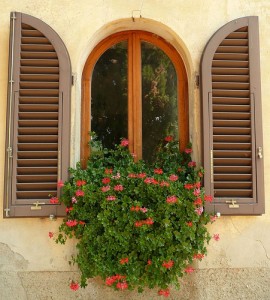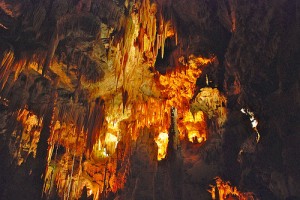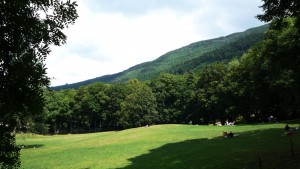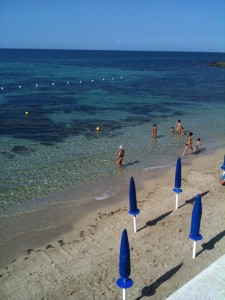
They’ve told you not to go to Italy in July or August because it’s dreadfully hot. But if it’s the only time you could visit – kids out of school, work is slow, whatever your reason – you’re going to need to do everything possible to keep cool. Here are a few solutions provided by a very warm resident of Florence, Italy.
Italian tradition maintains that a cold breeze from an open window or a fan can stiffen your neck permanently, cause terrible headaches or worse. For this reason, Italians tend not to have air conditioning or even fans at home or at work, although the new generation is starting to come around to the idea. Old buildings (some 50, some 500 years old) don’t lend themselves well to retrofitting for a/c. Schools and day care centers let out for a full three months because they don’t have cooling systems, and even summer camps close down in August!
As this populace has always dealt with the heat, they’ve developed a way of life, composed of both attitude and activities, that accommodate the summer weather. Don’t get me wrong, they suffer; they sit around and sigh che caldo (“it’s sooo hot”). But they do have a few tricks up their sleeves. After a decade of Italian living, I’ve culled these tips for you and added some of my own. We’ll start with some practical tips, and then move on to some suggestions for tourism in Italy’s hottest summer months.
Daily life suggestions
Close the shutters

If you grew up outside of Europe, like I did, you probably did not have functional shutters outside of your windows. You probably had blinds or curtains, but no big wooden way of blocking out the light. In Italy, all homes are equipped with one of two types of shutters: either the (usually green) wooden slatted kind that open to either side of the window, or in more modern buildings, a noisy roll-down device controlled by a pulley inside the house. Now I’m going to tell you something really obvious: those shutters do a lot to keep a room cool. In summertime, Italians open the shutters and windows widely in the early morning to help the cool air come in, but then shut everything up tightly by about 9am when the sun and warmer air heat things up. At night, usually we close the shutters but sleep with the windows open.
Get a fan

If you’re in a hotel or apartment rental without air conditioning, a fan is not necessarily provided automatically, but it does not hurt to ask for one. And if you’re staying for a longish period of time, you may decide to purchase a fan for yourself. It makes a huge difference, especially for sleeping on warm nights (and it helps block out any city noise, too!). Fans can be purchased at small electrics stores that you might see in city centers, at most mid to large sized supermarkets, and at any electronics store. A desk fan will run you 15-20 euros.
Take a nap
The daily rhythms projected by classic Italian films and our consequent stereotypes are no longer true in modern Italy: people don’t usually go home for lunch, take a nap, and put on a fresh shirt to return to the office. This was the case in the Italy of the family run business, the store that closed for lunch because mamma had to cook for papa, and there was nobody to man the till. With globalization, this process is almost, but not entirely, lost. Outside of the large cities of north and central Italy, stores still close for a long lunch hour – even supermarkets, department stores, and chains! Anywhere you go, churches close (usually between noon to about 3:30pm). In southern Italy in the summertime, it’s easy to find businesses that reopen at 5:30pm! Why? Because it is un-humanly hot. This leaves you with a bit of a hole in the middle of the day. Perfect for the “siesta”. After a sizable lunch, a nap is recommended! If you’re here as a tourist, just make sure you get your day started early enough to accommodate this long break in its middle.
Walk slowly
If you’ve done everything possible to avoid walking during the hottest hours of the day, walk slowly. Observe the Italians around you, especially the women, and you’ll see an economy in the way they walk, a way of not expending energy bouncing up and down the way we North Americans do. As a fresh arrival here, I used to call this the Italian Walk. It looks cool and effortless, and the amazing thing is that it works. Trust me and try it. The trick is to focus on going forward without going up, and to calibrate your breathing with your walking, like in yoga. (Please note: Italians also do not wear sun hats in the city. Doing so while doing the “Italian walk” will label you as a tourist right away!)
Tourism ideas
Having mastered the practical tips above, here are some tourist attractions that will help you keep cool during the hottest hours of the hottest months in Italy!
Go underground

Now for another obvious statement: Italy has a long history. But did you think about the layers that this history has left? Most apparent in Rome, where you will frequently see an ancient column incorporated into a modern doorway, over two thousand years of habitation makes for some interesting layers. The most well-known underground tours are, in fact, those of Rome. You can visit catacombs, acqueducts, and excavated villas (see a good article and list here). Just north of Rome in the town of Orvieto, you can keep cool in the Pozzo di San Patrizio, a 53 meter deep well built in the 16th century by the architect Antonio da Sangallo – you walk down an impressive double-helix stairwell of 248 steps (and back up, of course).
Italy is also full of natural grottoes and caves. In Tuscany, you can visit the Grotta del Vento (windy grotto) in the Apuane Alps near Lucca, where you can enjoy a constant temperature of 10.7 degrees centigrade. In the Marche region, take a 70 minute guided tour of the impressive Grotte di Frasassi where it’s 14 degrees and full of stalactites and stalagmites, colours and shapes. Down in Puglia the most famous underground visit is the Grotte di Castellana, in which it’s 18 degrees and very humid (waterproof shoes are useful for traversing some streams).
Find a public pool
If you’re traveling with kids, or desperate to cool off yourself, consider finding a swimming pool for a dip. Even if your chosen accommodation doesn’t offer this luxury (and in the city centers of Italy, pools are extremely rare), don’t despair! There are public swimming pools everywhere, even in small towns. The trick is knowing how to find them. The word for public pool in Italian is “piscina comunale“. You can search these words along with the name of the town or city on google and you’re likely to pull up a relevant result (in Italian, of course). You can also try “public pools in x” (name of town) since you may find that some friendly English language blogger has compiled them for you. In small towns, you may find directional road signs with these words; pools are usually located on the outskirts of the town.
There is usually a daily entrance fee to the pool, and you may find the place quite crowded, though a plus is that it’s great socializing for kids. You’ll need to bring your own flip flops, towel, and cover-up, and note that bathing caps are obligatory. The latter is usually for sale at the entrance, but if you can buy one at a sports store before going, you’ll spend less.
Head for the hills

In most Italian cities, locals have a favourite nearby destination for cool walks or dinners. Wherever you’re staying, find out what this is from your host or by talking to people. Often they are areas that can only be reached by car or by not entirely reliable public bus service (because for the most part they are located in the hills). Many of these places don’t have much else to offer beyond being cool, or maybe serving up a good meal, so they aren’t usually listed in tourist guides.
My personal experience is mostly in Tuscany, where I can tell you that Florentines get out of their hot city for dinners in the hills of Fiesole (accessible by city bus #7) or Monte Morello (not accessible by bus). A traditional summer day-trip is to the woods of Vallombrosa, about half an hour’s drive outside of the city (or longer on public bus). At 1000 meters above sea level and with shady woods, it’s a pleasant 20 degrees on a day that might be 40 degrees in Florence. Although there is an abbey, church, and small museum to visit here, the main activity is picnicking.
Go to the beach

If you can’t beat ’em, join ’em! Italy’s coasts offer marvelous sandy and rocky beaches, and this is where most Italians head in July and August, causing crowds and inflated prices. But there’s no question that heat is more bearable when you’re kissed by the sun and fanned by wind coming off the ocean. The west coast of the peninsula boasts turquoise waters and some impressive views, while the east coast tends to have warmer water, sandy beaches, and flatter landscapes. There is a rating system for beaches called “Bandiera Blu” (blue flag); the cleanest and best equipped beaches receive this annual honour, and you can check their website to find the nicest beach near you. If you’re in Italy in the summer, plan to include even just a day or overnight trip to the beach, which is closer than you may think.

